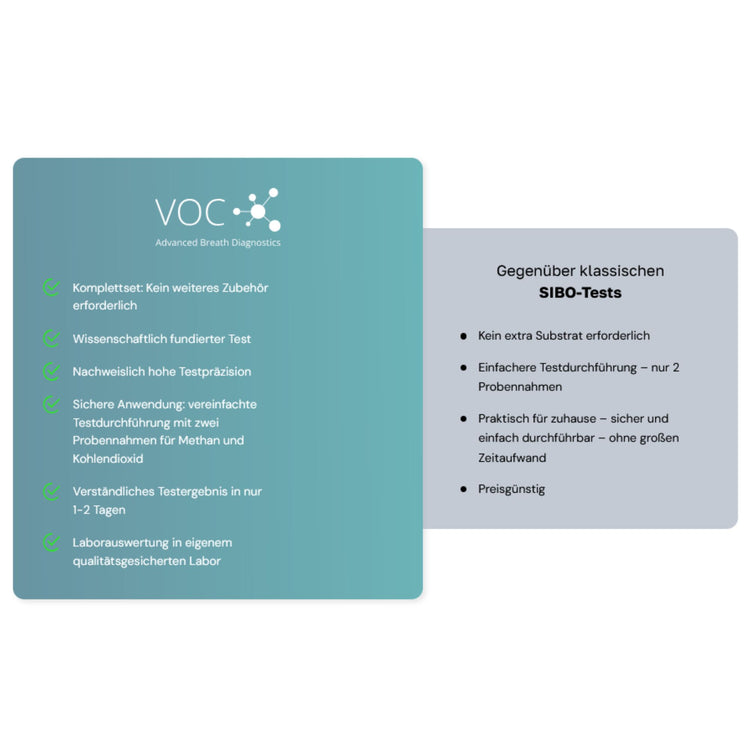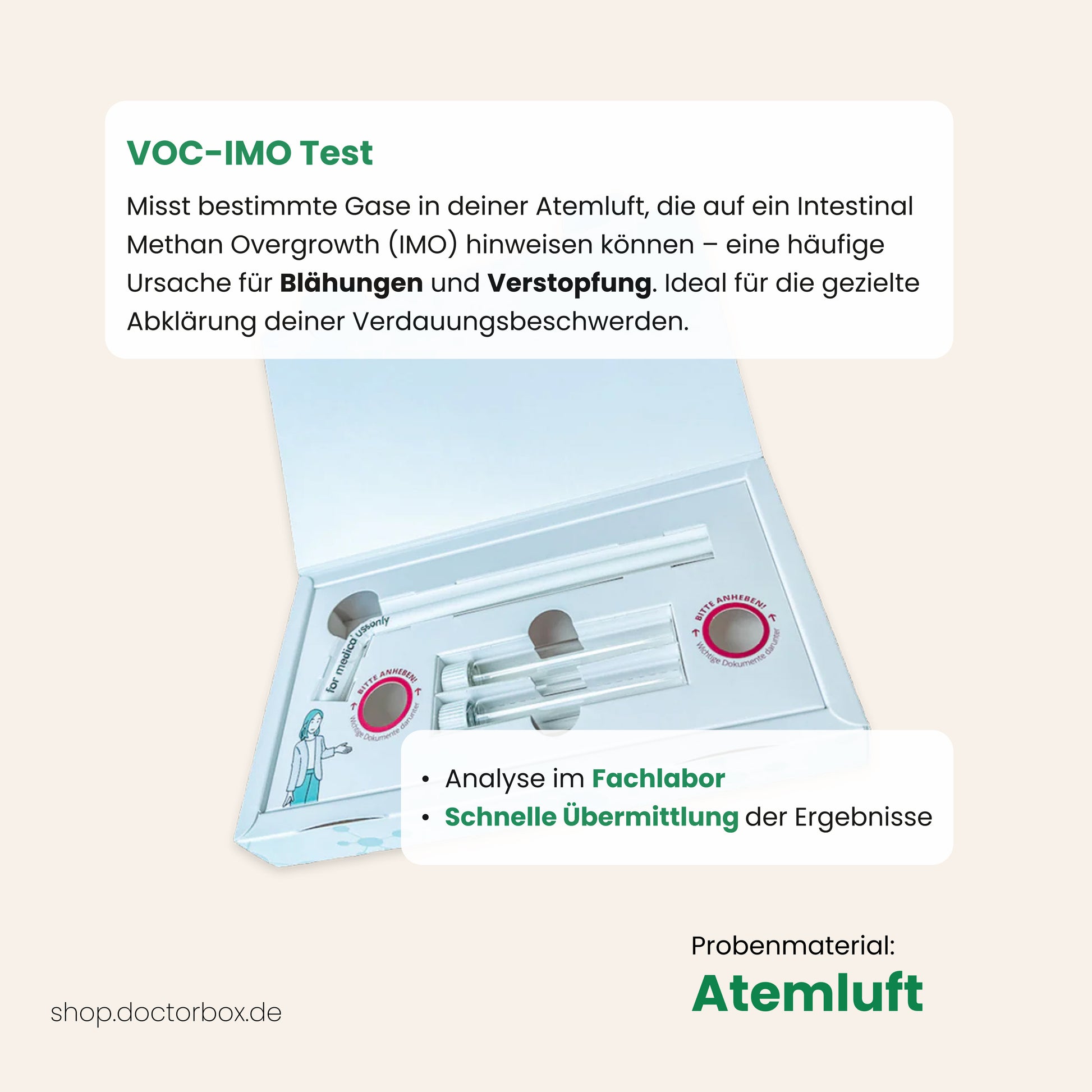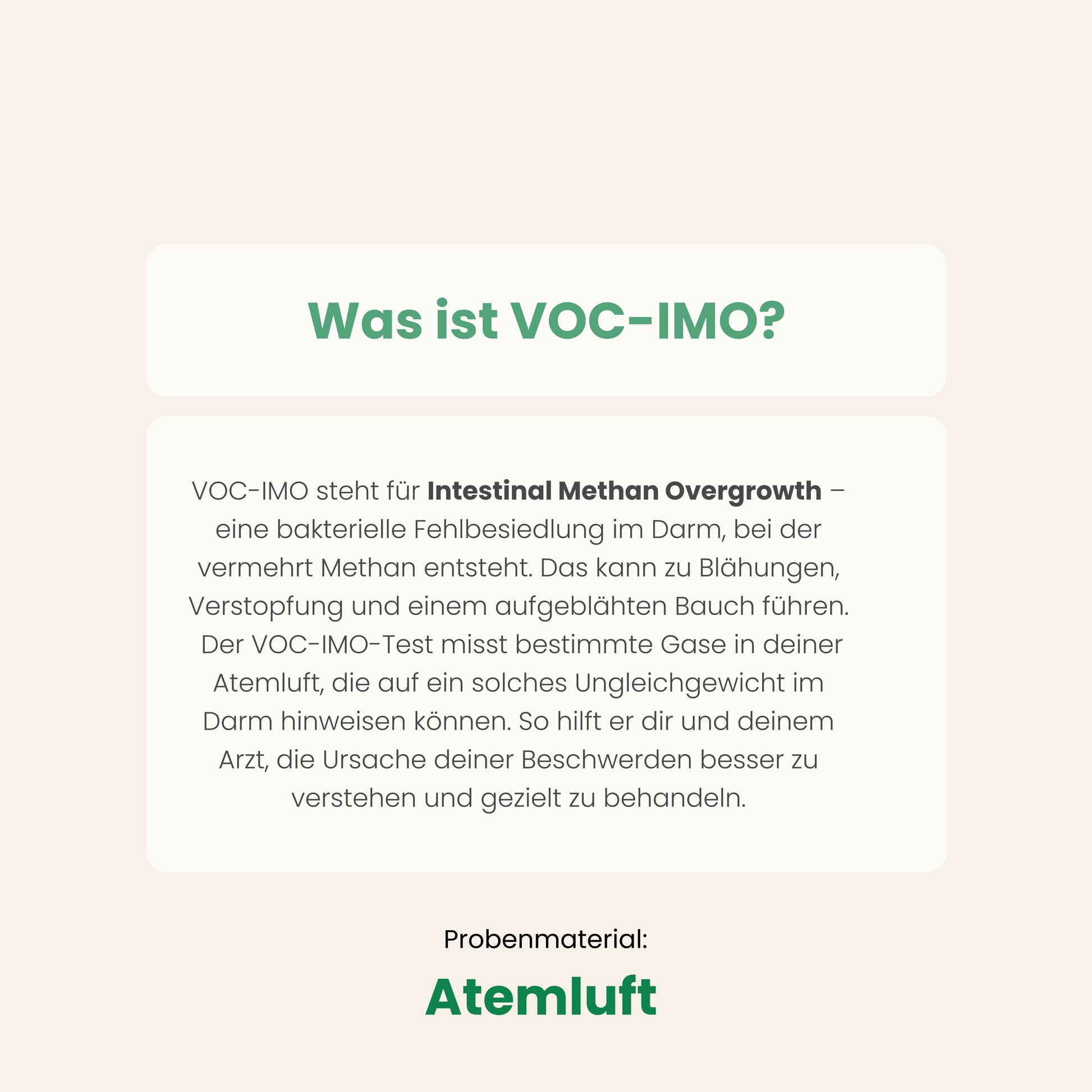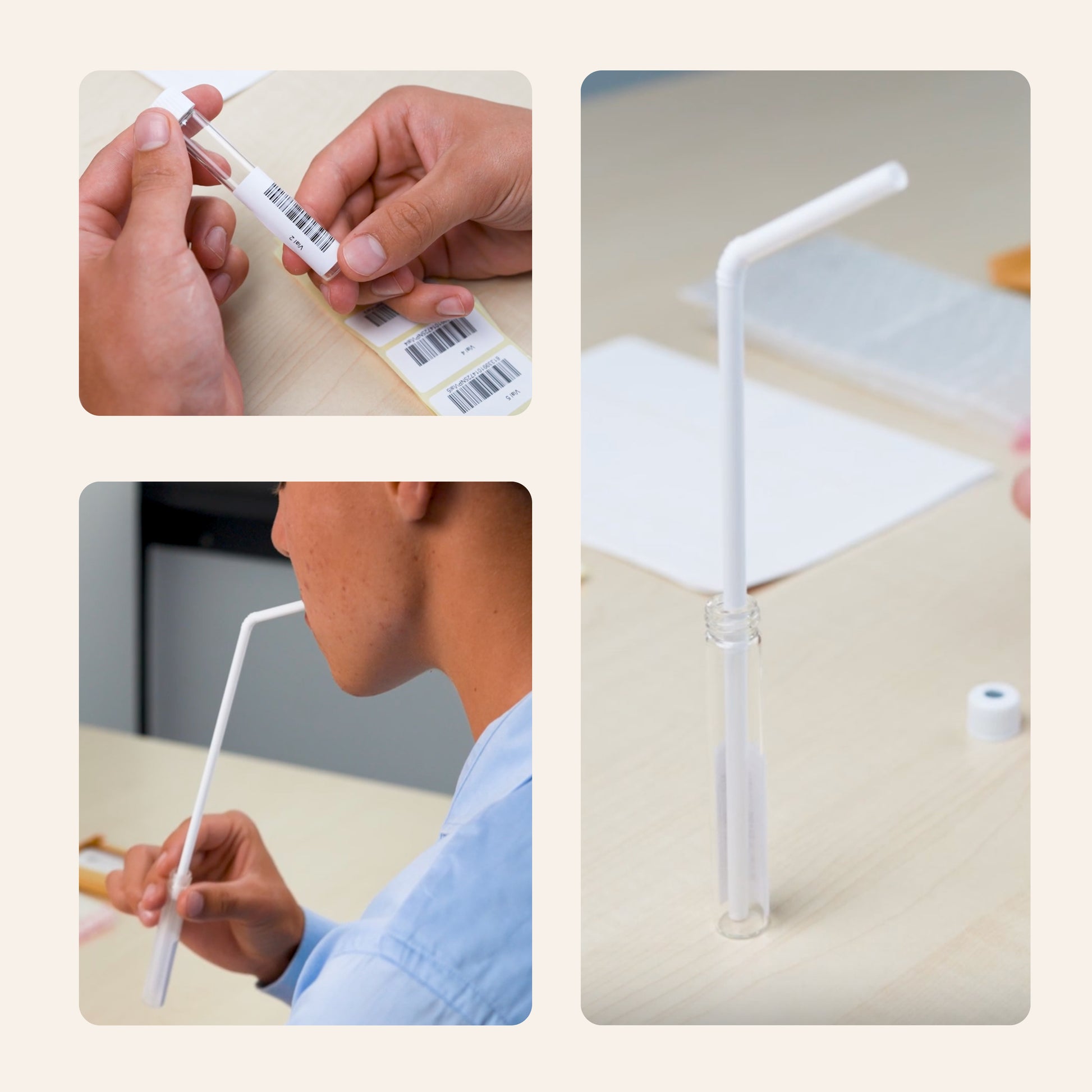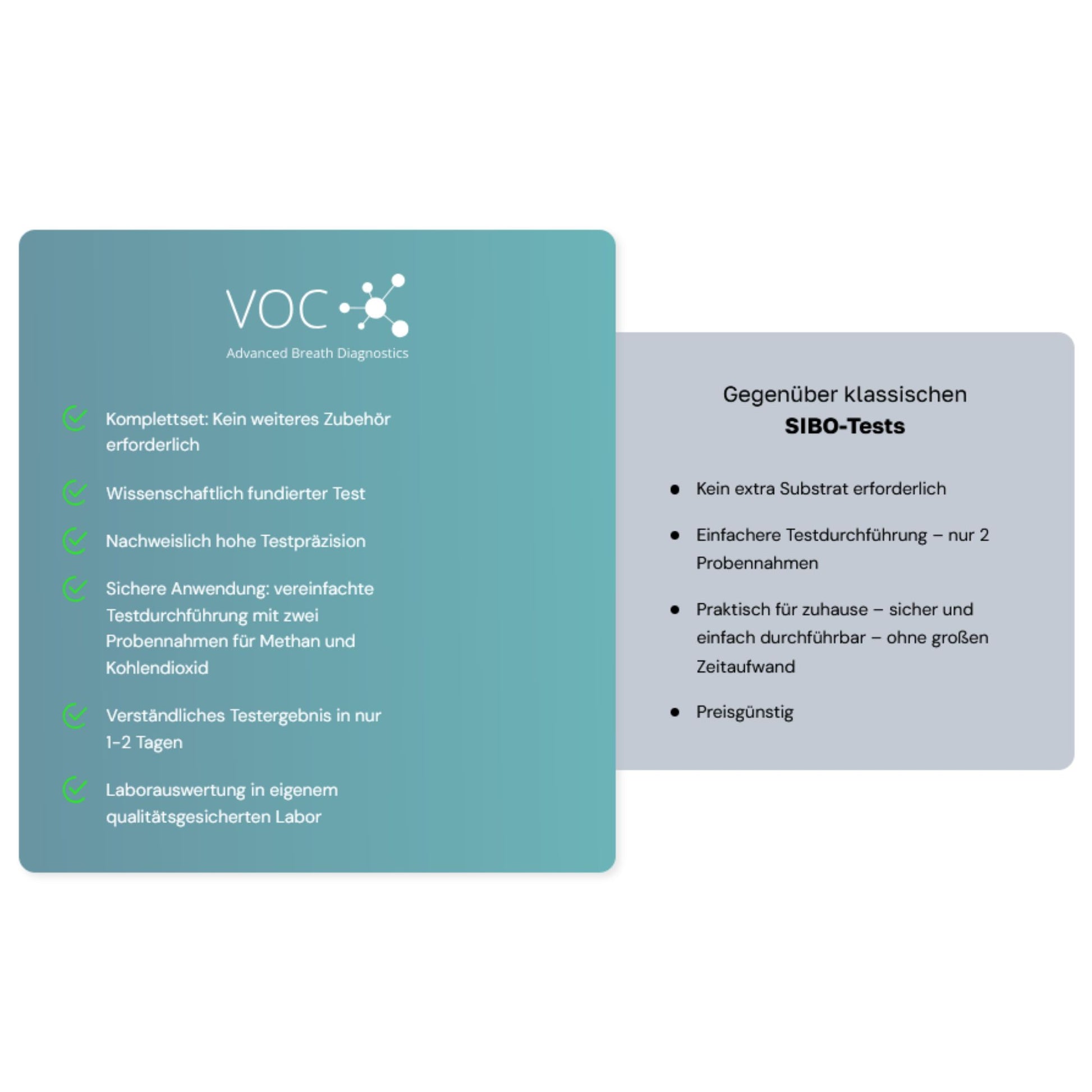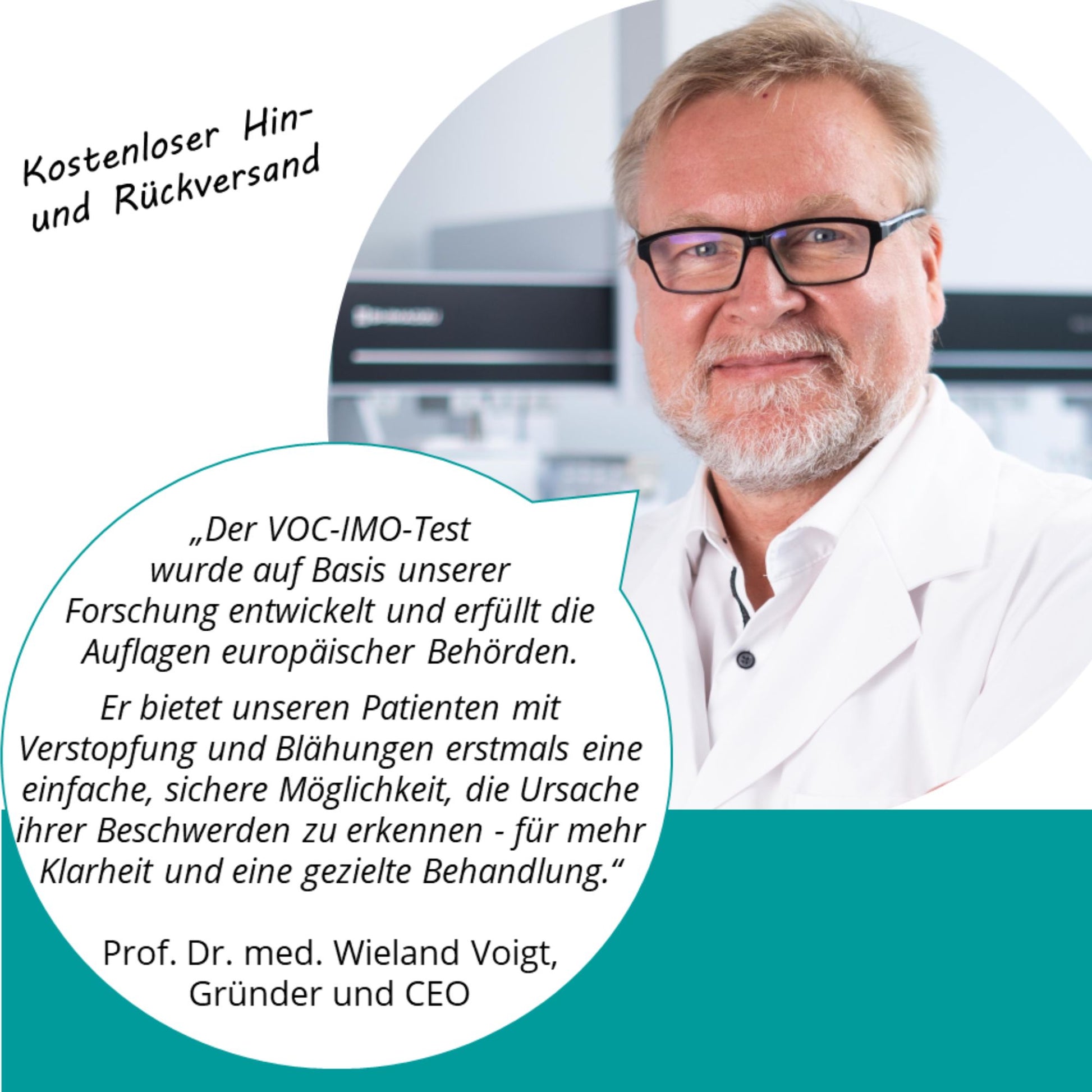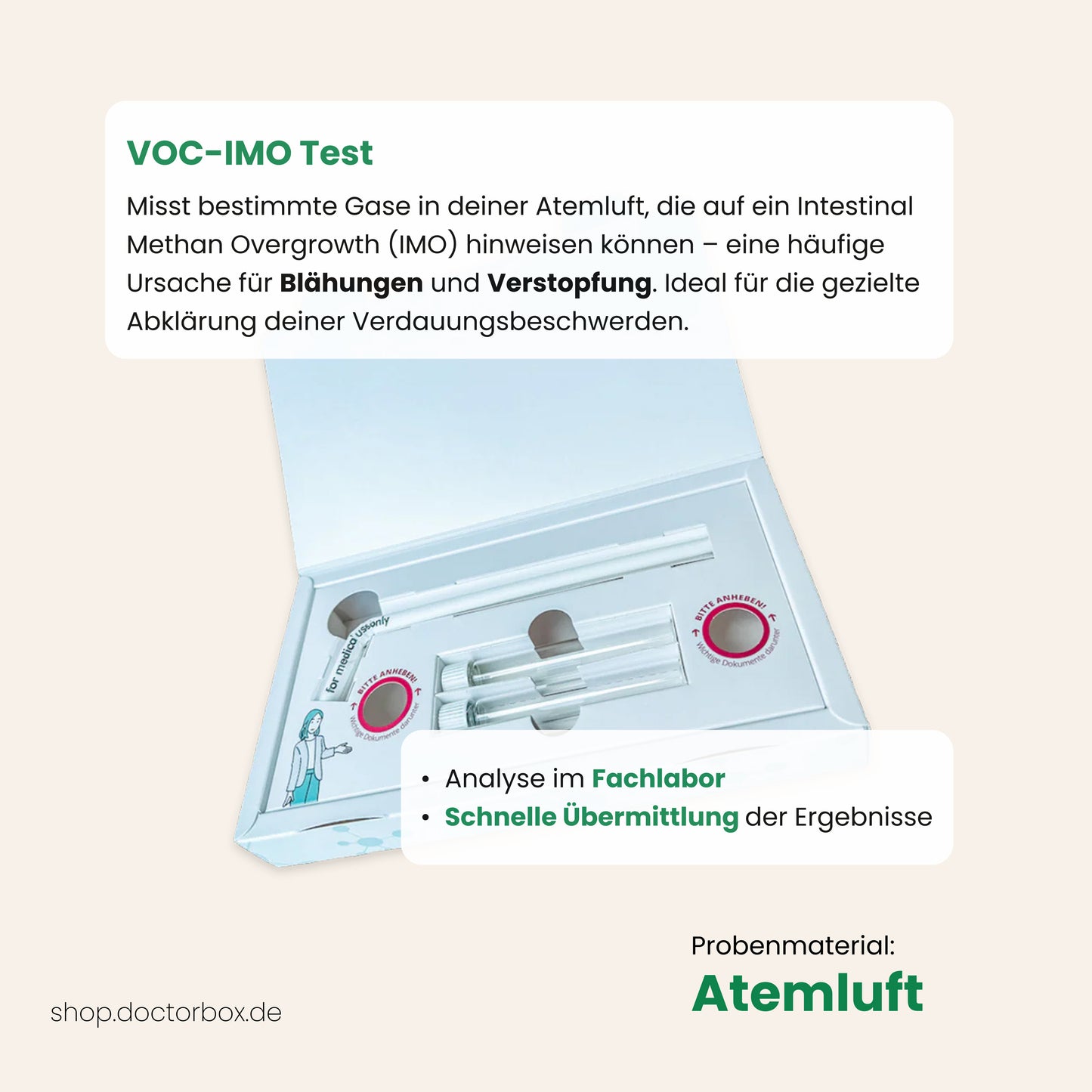
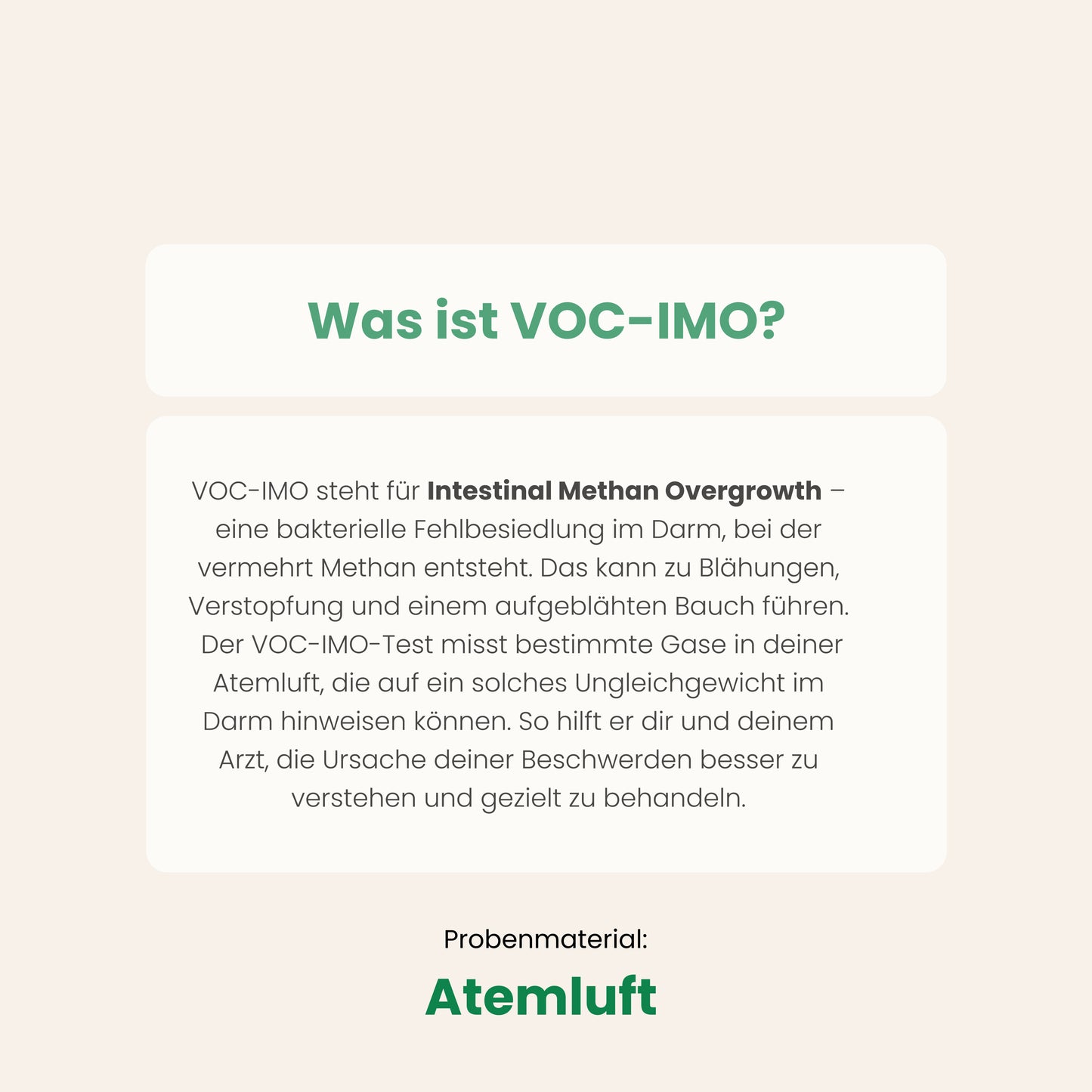
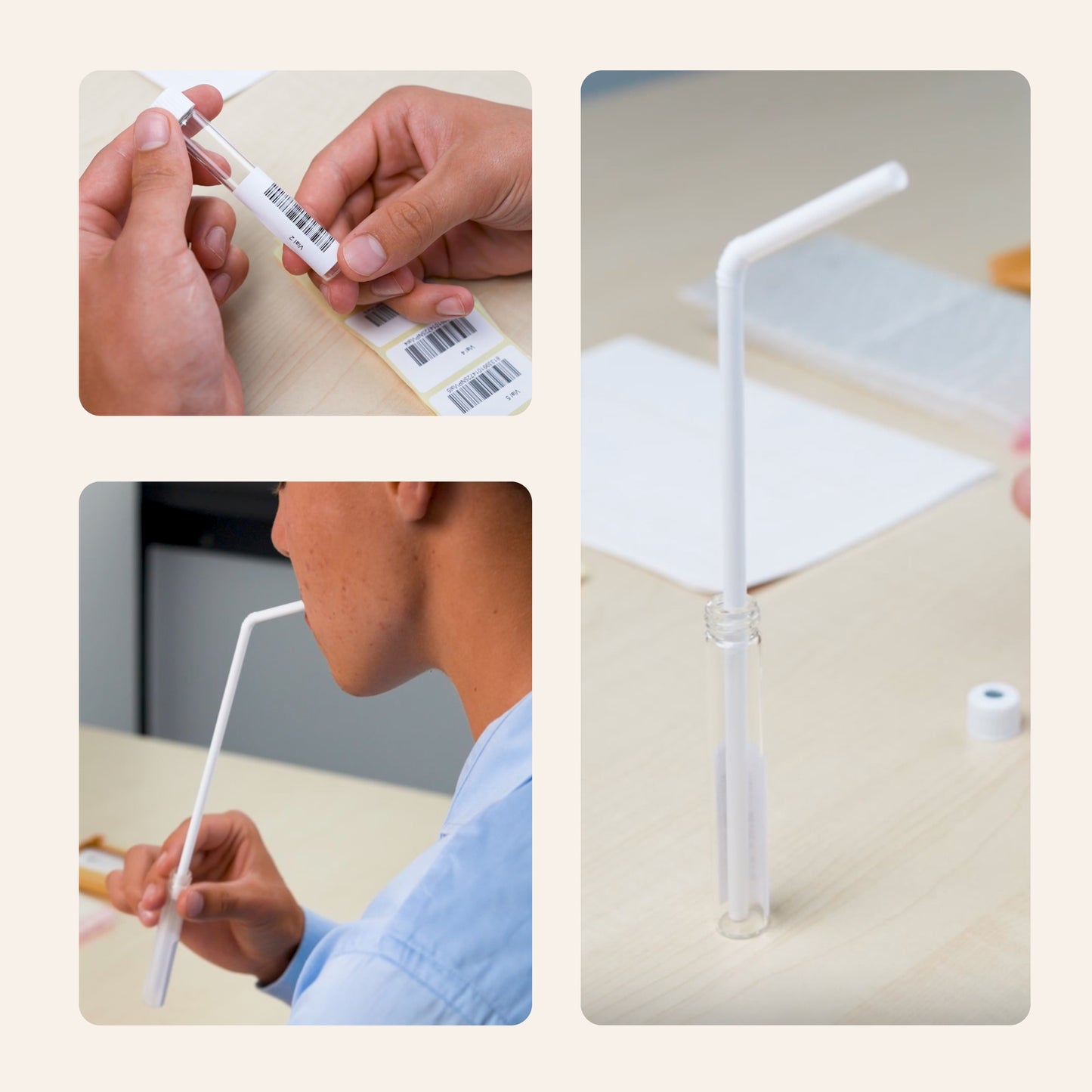
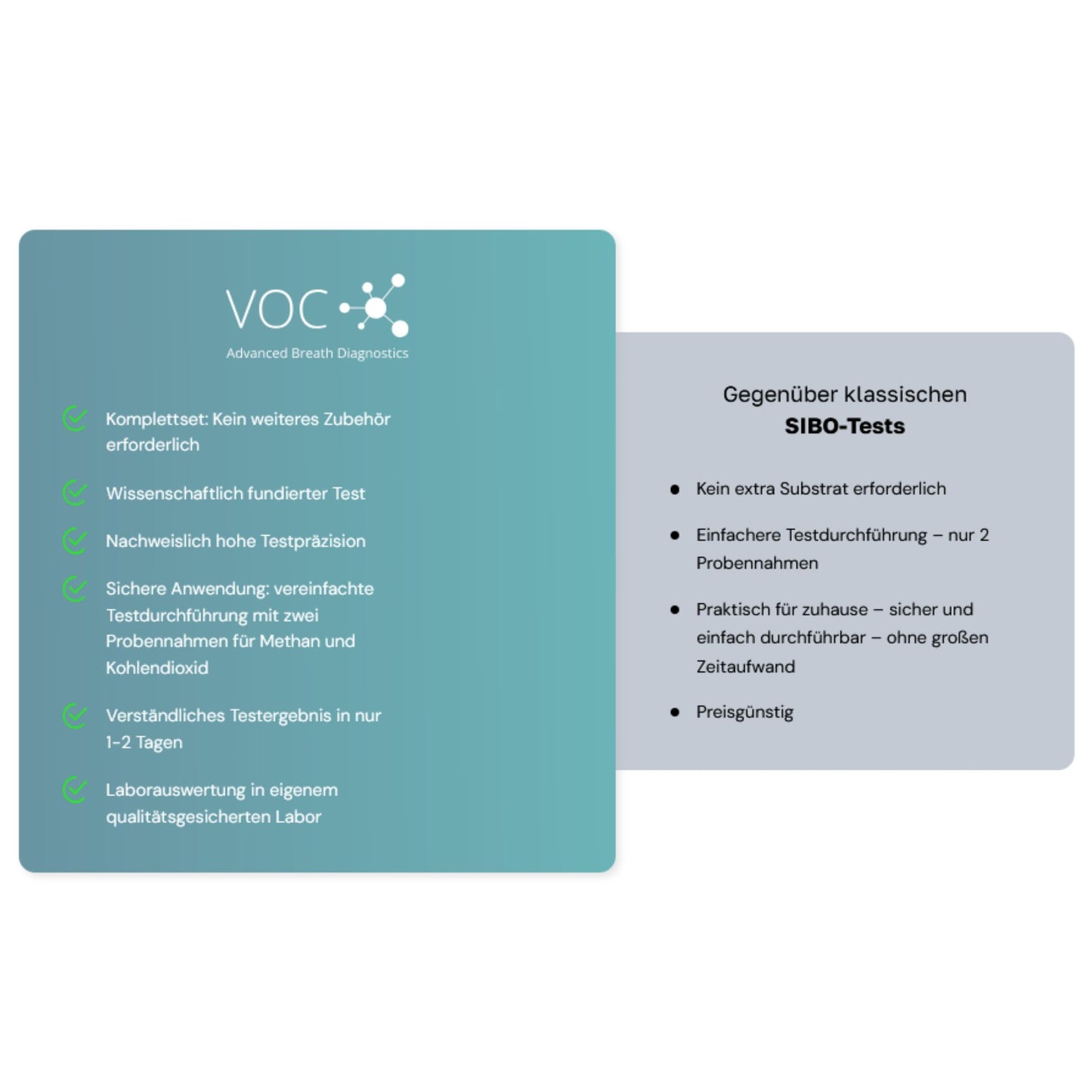
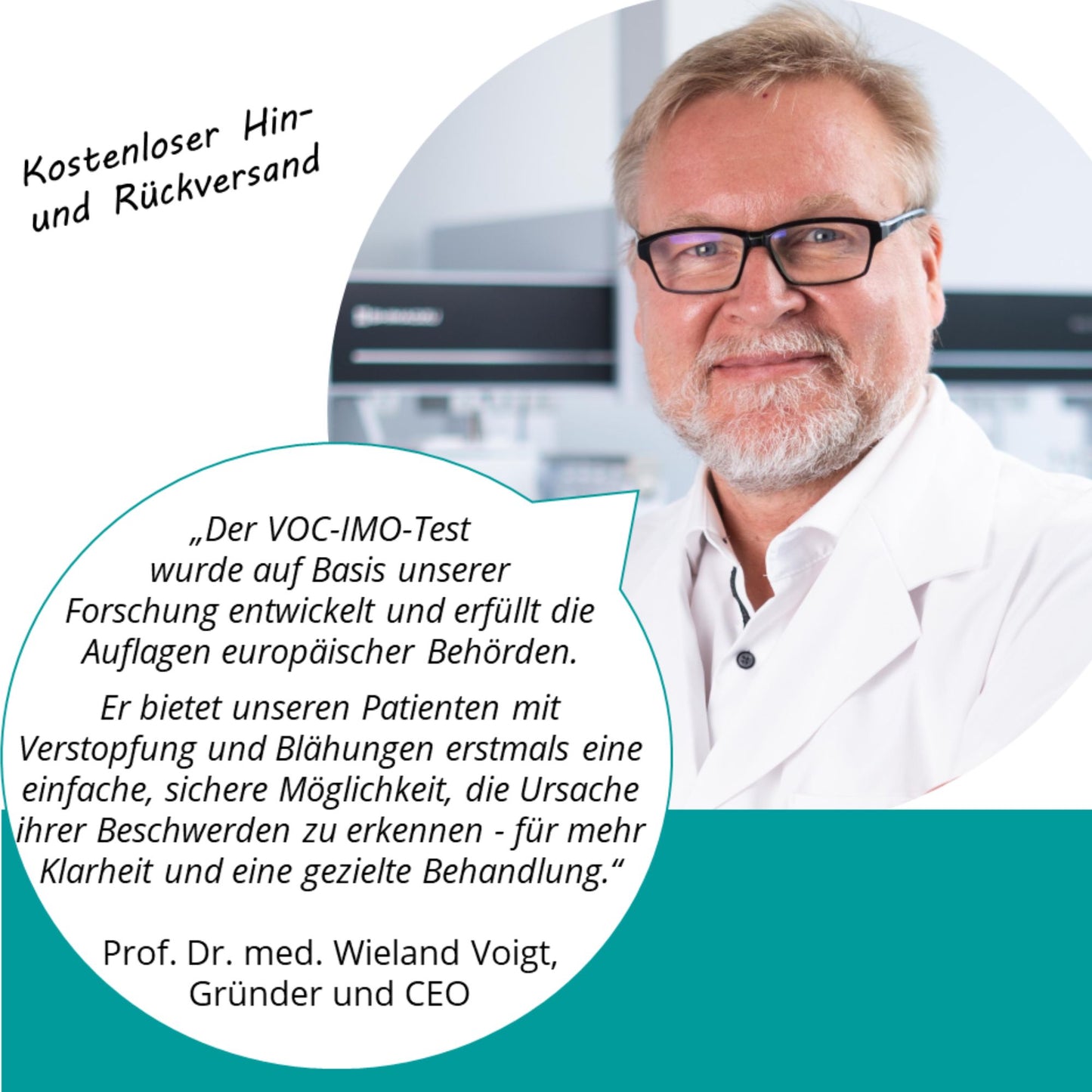
VOC-IMO Home Test – Analysis of Methane and Carbon Dioxide
For patients with bloating & constipation
If you suffer from symptoms like bloating, constipation, and a distended abdomen, you may have Intestinal Methane Overgrowth (IMO).
In this case, the VOC-IMO test supports you in the diagnostic clarification of your symptoms from age 16 and serves as a basis for your doctor or therapist to determine any necessary treatment.
Included in the test kit:
- Convenient, CE-marked test kit box with 2 breath sample tubes and a straw for two collection times
- Prepaid return envelope, test instructions, and additional informational materials
- Free shipping to and from the lab for your samples
- High-precision lab analysis for methane and carbon dioxide
- Questions answered and support provided via email.
- Comprehensive medical report that takes your individual symptoms and health information into account
More than just a test result:
Your report includes the measurements for methane (CH4) and carbon dioxide (CO2), plus an easy-to-understand interpretation and recommendations for further diagnostics.
We won’t leave you alone with your results. On our website, you’ll find detailed information about diagnostics and treatment options. The link provided also gives you access to a network of gut health and nutrition specialists.
Even after your test results, we’re here for you: In our information section, we present vetted products that can promote gut health and specifically alleviate your symptoms.
How to prepare optimally for the VOC-IMO test
The following guidelines are based on current medical recommendations and help you obtain the most meaningful test results:
- Antibiotic therapy: Ideally, allow at least 4 weeks between the end of therapy and the test—unless the test is being used to check the effectiveness of SIBO treatment.
- Colonoscopy: Also allow at least 4 weeks before starting the test.
- Probiotics and laxatives: Discontinue about 1 week before starting the test.
You can find more details in the enclosed instructions for use. The simple and reliable test procedure is supported by a detailed guide as well as an explanatory video.
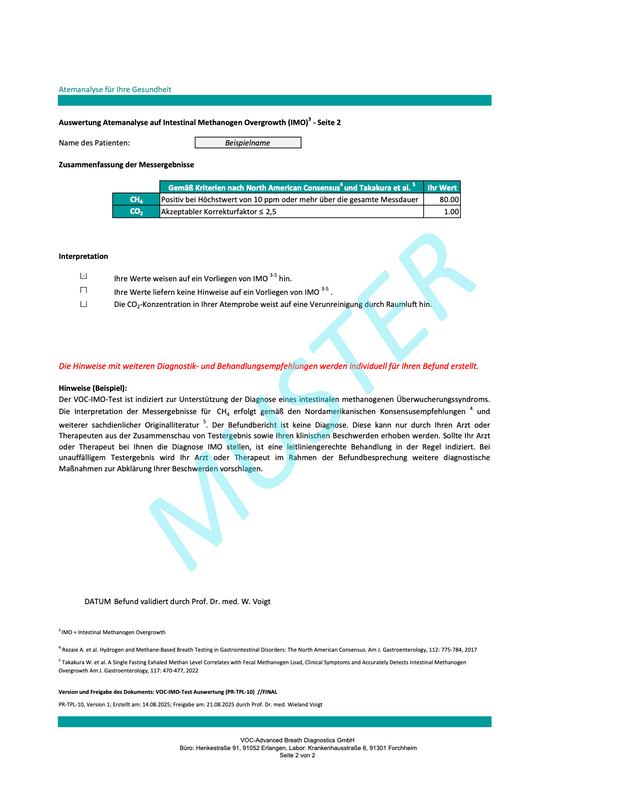
- If you are experiencing symptoms such as bloating, constipation, and a distended abdomen … (see also – what is IMO), it could be IMO.
- The VOC-IMO test helps clarify these symptoms in patients aged 16 and older, providing a basis for your doctor or therapist to determine any necessary treatment.
The IMO test (Intestinal Methanogen Overgrowth Test) is used to detect microbial overgrowth in the gut, where methane-producing microorganisms (mostly archaea) can cause symptoms like bloating, constipation, and abdominal pain.
Elevated methane levels in the breath indicate such an imbalance.
What are the essential steps in performing the IMO test?
Preparation: In the days leading up to the test, a special diet must be followed (no fiber, no gas-producing foods, no pro-/prebiotics, no antibiotics, etc.) to avoid skewing the results.
Sample collection:
- First breath sample: after 12 hours of fasting (fasting sample, for example, in the morning before breakfast).
- Food intake with time recorded
- Second breath sample: about 90 minutes after starting to eat.
Each breath sample is collected using the provided straw into a sample tube and sealed airtight.
Shipping:
The filled tubes are sent to the lab together with a documentation form and patient questionnaire using the included return envelope.
Analysis:
The specialized lab measures the concentration of methane and carbon dioxide in the samples. The results are summarized in a medical report and interpreted according to guidelines. This report supports the treating physician in diagnosis and treatment decisions, but does not itself constitute a final diagnosis.
Breath collection follows a defined procedure (see test instructions and explanatory video) using a specially approved breath sampling method.
With the VOC-IMO test kit, you’ll receive detailed instructions for preparing for and performing the test. The instructions are based on recommendations from European and American medical guidelines for SIBO testing. Please read the instructions carefully and follow the recommendations, as this is the only way to ensure reliable test results.
- Click here for the explanatory video.
- After returning the test tubes to the submission laboratory of VOC-Advanced Breath Diagnostics GmbH, the samples are analyzed within one day using gas chromatography, and the results are evaluated by our medical experts.
- After multiple quality control steps, the diagnostic report is uploaded to a secure cloud storage. At the same time, you will receive an email with a link allowing you to view your results.
- Like other comparable breath tests, the VOC-IMO test consists of a preparation phase and the actual test procedure. All necessary steps are described in detail in the test instructions and illustrated with images.
- It’s important to follow the recommendations exactly to obtain a reliable test result. Please read the test instructions carefully and contact us by email if you have any questions.
- The VOC-IMO test uses a specially developed method to measure methane and carbon dioxide in a single measurement process. This ensures particularly high precision in breath analysis.
- If concentrations of methane defined in the guidelines are exceeded over a certain period of time, the test is considered positive.
- The test is divided into the test preparation phase and the actual test procedure.
- The test procedure conveniently starts, for example, at 7 a.m. with labeling the test tubes with barcodes, collecting a baseline breath sample, and then having breakfast.
- 90 minutes after starting breakfast, you take the second breath sample.
- Before performing the test, certain dietary instructions must be followed, and specific medications that affect intestinal motility should be avoided if possible (please consult your doctor or therapist about this), and certain procedures such as a colonoscopy should be as long ago as possible.
- Certain procedures, such as a colonoscopy, should ideally be at least 4 weeks or more in the past. It is also important that any antibiotic therapy should have ended at least 3–4 weeks prior.
- Further information can be found in our test instructions.
So funktioniert's
Atemprobe für IMO-Test
Sie erhalten die Testkitbox per Post mit einer genauen Testanleitung, wie die Atemprobensammlung zu Hause durchgeführt wird – auch hier als Video.
Sie bestimmen flexibel den Zeitpunkt der Vorbereitung und Durchführung.
Detaillierter Befundbericht
Ihr Befundbericht enthält die Messergebnisse für Methan (CH4) und Kohlendioxid (CO2) plus eine gut verständliche Interpretation und Hinweise zur weiteren Diagnostik.

Nächste Schritte
Ergibt die Atemanalyse Hinweise auf SIBO oder IMO, finden Sie Behandlungstipps und Experten für Darmgesundheit und Ernährung in unserer Übersicht:

